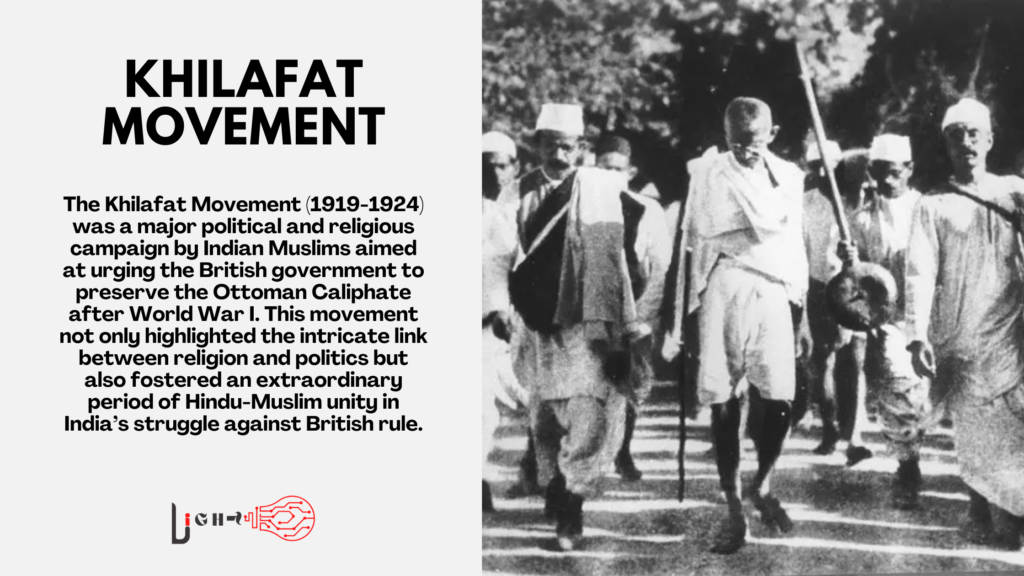The Khilafat Movement was a significant political and religious campaign initiated by Indian Muslims from 1919 to 1924. Its primary goal was to pressure the British government to maintain the Ottoman Caliphate after the defeat of the Ottoman Empire in World War I. This movement represented a critical moment in Indian history, reflecting the complex interplay between religion and politics. The Khilafat Movement also marked a period of unprecedented Hindu-Muslim unity in India’s struggle against British colonial rule. Understanding this movement is crucial to comprehending the broader context of India’s fight for independence and the subsequent communal dynamics that emerged in the subcontinent.
Causes of the Khilafat Movement
The Khilafat Movement emerged from a combination of religious and political factors that catalyzed the Indian Muslim community into action.
Post-World War I Political Dynamics
After World War I, the global political landscape changed dramatically. The Ottoman Empire, a long-standing symbol of Islamic unity and power, faced disintegration due to the Allied powers’ victory. Indian Muslims felt deeply connected to the fate of the Ottoman Caliph, who was considered the spiritual leader of the Islamic world. The British decision to dismantle the Ottoman Caliphate was perceived as an affront to Islamic authority, sparking widespread discontent among Muslims in India. This dissatisfaction found a voice through the Khilafat Movement, which sought to exert pressure on the British government to reconsider their stance.
Religious Concerns of Indian Muslims
For many Indian Muslims, the Khilafat Movement was more than just a political endeavor; it was a religious obligation. The Caliphate was viewed as a unifying force for Muslims worldwide. The prospect of its dissolution was a spiritual crisis that compelled Muslims to rally in its defense. The movement’s religious undertones helped it gain momentum quickly, as it appealed directly to the devout sentiments of the Muslim community. This religious fervor provided a robust foundation for what would become a significant political movement, blending spiritual duty with political activism.
Major Events and Milestones
The Khilafat Movement saw a series of critical events that shaped its trajectory and its ultimate influence on Indian society.
The Role of the Khilafat Committee
The Khilafat Committee, formed in 1919, played a central role in organizing and directing the movement. It coordinated protests, meetings, and petitions to present a unified demand to the British authorities. The committee, composed of prominent Muslim leaders like Maulana Mohammad Ali and Shaukat Ali, acted as the movement’s strategic backbone. They sought to align their efforts with other Indian political movements to maximize their impact, demonstrating a commitment to a broader nationalistic agenda beyond just Muslim concerns.

Gandhi’s Alliance with the Khilafat Movement
Mahatma Gandhi saw an opportunity in the Khilafat Movement to unite Hindus and Muslims against a common colonial adversary. He joined forces with the movement, advocating for non-cooperation with the British as a strategy for both Hindu-Muslim unity and self-rule. This alliance was instrumental in bringing together different communities under a single nationalist umbrella. However, this unity was fragile, based more on shared opposition to British rule than on lasting communal harmony, a fact that became evident as the movement progressed.
Pattom A. Thanu Pillai: The Visionary Behind Kerala’s Political Evolution
To know more click here:https://light.vintbit.com/kerala-history/pattom-a-thanu-pillai-politics/
Decline and End of the Movement
Despite its initial successes, the Khilafat Movement began to wane by the early 1920s.
The Treaty of Lausanne and Its Impact
The 1923 Treaty of Lausanne marked a turning point for the Khilafat Movement. The treaty formally ended the Ottoman Empire and the institution of the Caliphate, which had been the movement’s central cause. With the Caliphate abolished, the movement lost its primary objective, leading to its gradual dissolution. The movement’s leaders were left to grapple with the new political reality, and the focus of Indian nationalism began to shift back towards secular, rather than religious, issues.
Impact of the Khilafat Movement on Indian Independence
The Khilafat Movement had a lasting impact on the political landscape of India and the fight for independence.
Hindu-Muslim Unity and its Shortcomings
Initially, the Khilafat Movement brought Hindu and Muslim communities together in a show of solidarity against colonial rule. However, the unity was superficial and largely contingent on immediate political needs rather than a genuine resolution of communal differences. Once the primary goal of the movement dissipated, so did the unity. The communal tensions that re-emerged laid the groundwork for future discord and eventual partition.1
Conclusion
The Khilafat Movement remains a pivotal chapter in India’s history, illustrating the interplay of religion and politics during the struggle for independence. While its immediate goals were not achieved, the movement significantly influenced the political awakening among Indian Muslims and set the stage for future movements. The lessons from the Khilafat Movement, particularly regarding communal unity and political strategy, continue to resonate in India’s contemporary socio-political landscape.

